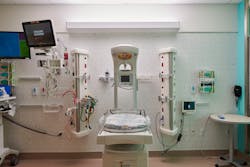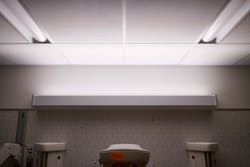A century ago, a baby born prematurely in the U.S. had little chance of survival. Today, thanks to major advances in neonatal care, preterm infants, defined as babies born more than 3 weeks early, can live long and healthy lives. But challenges remain. Many preterm infants have trouble growing and gaining weight. Some suffer from chronic lung disease or immune system issues. They are also at a greater risk of abnormal retinal development, which can lead to permanent visual impairment.
The country’s first neonatal intensive care unit (NICU) was established in Connecticut in 1960, with more NICUs built at hospitals across the country in subsequent decades. Initially, NICUs were brightly illuminated 24/7 so that physicians and nurses could observe and tend to their vulnerable patients. The late 1980s saw a reversal: Medical directors began dimming their NICUs, believing that lighting should remain at very low levels 24/7 to replicate the darkness of the intrauterine environment.
A growing body of research is challenging past assumptions on the type of lighting that infants require. In the womb, the fetus receives circadian cues, including changes in the mother’s body temperature and hormones, which follow a pattern throughout the 24-hour day. However, once the baby is born, they no longer receive these cues from their mother. The earlier this connection is lost, the greater the risk of permanent health issues to the baby, such as reduced growth.
Lightbulb moment
A team of physicians, researchers, and architectural lighting experts are currently working together to address the problem of lost circadian cues through lighting science and application. Since the turn of the 21st century, scientists have learned much about the importance of circadian light–dark cycles for human health. Light has an impact on human health via opsins, located in the brain: Melanopsin plays a key role in controlling circadian rhythms, including sleep/wake cycles, while encephalopsin and neuropsin influence physiologic and metabolic processes, such as growth.
In 2020, Richard Lang, director of the Visual Systems Group at Cincinnati Children’s Hospital Medical Center, discovered that opsins sense specific wavelengths of light that are found in sunlight, but not in electric light. This finding inspired Lang’s colleague James Greenberg, co-director of the Perinatal Institute at Cincinnati Children’s, to develop a lighting system for the institution’s NICU. Greenberg envisioned building a circadian lighting system capable of providing the full range of visible wavelengths found in sunlight to support optimal neonatal growth and development.
At the time, Cincinnati Children’s was working with ZGF Architects on the design and construction of a major facility expansion—an eight-story, 632,500-square-foot Critical Care Building. Greenberg began collaborating with ZGF, Pivotal Lighting Design, BIOS Lighting, and Acuity Brands to develop a lighting system for the NICU that would support the health and well-being of preterm infants.
The lighting system cost approximately $4 million to design, test, and build. In November 2021, the biologically aware circadian lighting system was installed in 56 patient rooms at the Critical Care Building. Linear in form, low-profile, and approximately 6 feet in length, the luminaire looks like the standard headwall fixtures in other patient rooms throughout the hospital with one major difference: It delivers the ideal quantity and quality of light that newborns require during this critical period of development.
From research to product
Through its tunable LEDs and custom user interface, which support sophisticated spectral manipulation, the lighting system is programmable for any latitude, reflects the seasonal variation in length of day, and accurately mimics the gradual and constantly changing spectral composition of light during the 24-hour progression from dawn to midday, dusk, and through the night.
The circadian lighting system provides the full range of visible wavelengths found in sunlight, including violet light, to support vision, circadian rhythm, and growth. “Violet light found in skylight and sunlight plays a role in human development, but you cannot rely on daylight within a NICU environment because of sensitivity to temperature and glare,” says ZGF principal Marty Brennan. “Even if you can control those variables, the glazing assembly can diminish violet wavelengths.”
“Beyond just hitting the spectral targets, it was important that the spectrally tuned fixture be able to produce a color quality and appearance that felt natural and cohesive with the rest of the architectural lighting,” says Grant Kightlinger, senior lighting designer at Pivotal Lighting Design. “Before the manufacturer began fixture development, we defined the acceptable ranges for color temperature, color fidelity, and gamut that needed to be met.”
The wall-mounted luminaires use a fully indirect distribution to minimize glare and protect the delicate eyes of the infants. The fixture is positioned at the headwall to illuminate the ceiling directly above the infant to optimize the delivery of reflected light.
“High-output direct exam lighting is also available for certain procedures and for emergencies," Kightlinger says, "but the indirect-only mode is sufficient for routine observation and tasks, and it fills the patient’s field of view with the prescribed spectrum of light."
Growing the literature
Before and after the lighting system’s installation, Cincinnati Children’s provided training and education on its proper use for its nurses, physicians, and other bedside care providers, along with its infrastructure management team and IT team. “To get healthy outcomes from nonvisual spectral lighting requires education and outreach,” Brennan says. “If care staff and families understand the lighting as medicine, there is a much greater chance of acceptance and participation.”
Cincinnati Children’s has also conducted three post-occupancy surveys of bedside care providers. The feedback has been overwhelmingly positive. “Our nurses really like the light,” Greenberg says. In fact, the lighting system will soon be installed in 23 additional rooms at Cincinnati Children’s NICU. Though the technology is not yet available for other medical facilities, Greenberg’s goal is for the system to become more widely available in the next three to five years. “We think it would be valuable,” he says.
Parents of the newborn patients at Cincinnati Children’s NICU have also offered positive feedback about the lighting system. “There has been general acceptance and support for the lights,” Greenberg says.
The lighting system is designed not only to support the health and well-being of preterm infants, but also to facilitate continuing research on the impact of full spectrum lighting on infant growth and development. As might be expected, parents have also expressed interest in how the lights would benefit their child.
The first research study started in November 2022, and a second study is starting now. “We are looking at how light can regulate metabolic activity and growth through activation of nonvisual opsins,” Greenberg says. “We are hopeful that preliminary results for some of our studies may be available to share in the next 12 months or so.”
Lang and Greenberg envision using a multidisciplinary approach to connect basic discoveries on light-sensing pathways in humans to the practice of medicine and the delivery of health care.
“Health care design must be evidence-based, which calls for collaborative applied research processes,” Brennan says. “Our hope is that the clinical trials administered through the Science of Light Center at Cincinnati Children’s, led by Drs. Richard Lang and James Greenberg, contribute new findings about the health benefits of visible light and inform future lighting design guidelines across the built environment.”
“Modern glass blocks important parts of the spectrum,” Greenberg says. “Replacing this part of the natural daylight spectrum will help not just babies, but everyone.” This might include individuals with circadian disruptions who, for example, must stay indoors for work or for health reasons.
Design software solutions
For architects and lighting designers interested in creating environments that support health and well-being through the nonvisual effects of light, Brennan recommends utilizing Lark Spectral Lighting, a peer-reviewed, open-source software developed by ZGF and the University of Washington. Version 3, which adds opsin 5 (neuropsin) to the toolkit, was recently released. Version 1 was the first lighting design simulation tool to include opsin 4 (melanopsin). The tool allows users to input custom spectral power distributions for the sky, sun, electric lights, glazing, and finish materials; it then computes the impact of design strategies on nonvisual, circadian light.
At Cincinnati Children’s, the team used Lark Spectral Lighting to simulate the health impacts from different daylight and electric lighting options. “We show through simulation that the NICU design achieves adequate nonvisual illuminance for OPN 4 and 5 at the isolette with full-spectrum light sources mimicking daylight,” Brennan says.
He also suggests utilizing resources from the International WELL Building Institute. “The WELL standard is a good starting point for melanopsin OPN 4 illuminance levels,” Brennan says. “OPN 5 neuropsin illuminance is not yet prescribed and a bit harder to accommodate, as many luminaires do not have violet LED chips.” His advice for architects and lighting designers in the meantime: “Engage manufacturers early to see what options are available to expand the visible light range.”









